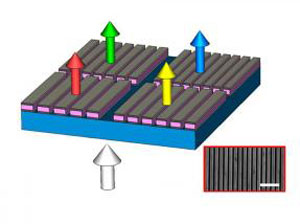 University of Michigan scientists using AFOSR-funding have created the smallest pixels available that will enable LED, projected and wearable displays to be more energy efficient with more light manipulation possible and all on a display that may eventually be as small as a postage stamp.
University of Michigan scientists using AFOSR-funding have created the smallest pixels available that will enable LED, projected and wearable displays to be more energy efficient with more light manipulation possible and all on a display that may eventually be as small as a postage stamp.
Sep 28th, 2010
Read more
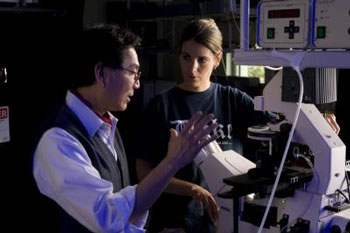 Duke University bioengineers have not only figured out a way to sneak molecular spies through the walls of individual cells, they can now slip them into the command center - or nucleus - of those cells, where they can report back important information or drop off payloads.
Duke University bioengineers have not only figured out a way to sneak molecular spies through the walls of individual cells, they can now slip them into the command center - or nucleus - of those cells, where they can report back important information or drop off payloads.
Sep 28th, 2010
Read more
The NanoCode Project has recently published a Synthesis Report that provides a broad overview of current codes of conduct, voluntary measures and practices aimed toward promoting responsible development of nanoscience and nanotechnologies, and which compares these with the provisions of the Code of Conduct for nanotechnology research as proposed by the European Commission. The report includes information drawn from individual country reports prepared by each of the NanoCode partners that covered the situation in their own country.
Sep 28th, 2010
Read more
27 europaeische Unternehmen und institutionelle Forschungseinrichtungen aus den Branchen Halbleiterindustrie, Geraete- und Materialhersteller haben sich zum Verbundprojekt EEMI450 (European Equipment and Materials Initiative for 450 mm) zusammengeschlossen, mit dem Ziel, 450 mm-Technologie und Know-how fuer den Standort Europa zu sichern.
Sep 28th, 2010
Read more
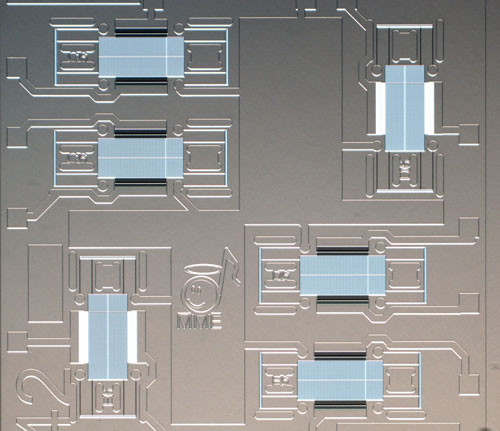 Strings a fraction of the thickness of a human hair, with microscopic weights to pluck them: researchers and students from the MESA+ Institute for Nanotechnology of the University of Twente in The Netherlands have succeeded in constructing the first musical instrument with dimensions measured in mere micrometres - a 'micronium' - that produces audible tones.
Strings a fraction of the thickness of a human hair, with microscopic weights to pluck them: researchers and students from the MESA+ Institute for Nanotechnology of the University of Twente in The Netherlands have succeeded in constructing the first musical instrument with dimensions measured in mere micrometres - a 'micronium' - that produces audible tones.
Sep 28th, 2010
Read more
With the Singapore Government injecting S$16.1 billion on Research, Innovation and Enterprise (RIE) from 2011 to 2015, the entire RIE ecosystem has been set abuzz. Singapore's long-term goal is to be among the most research-intensive, innovative and entrepreneurial economies in the world to generate high value jobs and prosperity for Singaporeans.
Sep 28th, 2010
Read more
The National Institutes of Health (NIH) will award $9.4 million over three years to support four research projects in regulatory science. The projects include research on nanoparticles and their characterization.
Sep 28th, 2010
Read more
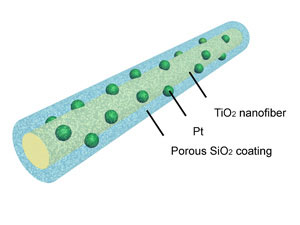 Control over material properties would reduce the amount of platinum needed.
Control over material properties would reduce the amount of platinum needed.
Sep 27th, 2010
Read more
Computers might one day recycle part of their own waste heat, using a material being studied by researchers at Ohio State University. The material is a semiconductor called gallium manganese arsenide. The researchers describe the detection of an effect that converts heat into a quantum mechanical phenomenon - known as spin - in a semiconductor.
Sep 27th, 2010
Read more
Ultra-thin solar cells can absorb sunlight more efficiently than the thicker, more expensive-to-make silicon cells used today, because light behaves differently at scales around a nanometer (a billionth of a meter), say Stanford engineers. They calculate that by properly configuring the thicknesses of several thin layers of films, an organic polymer thin film could absorb as much as 10 times more energy from sunlight than was thought possible.
Sep 27th, 2010
Read more
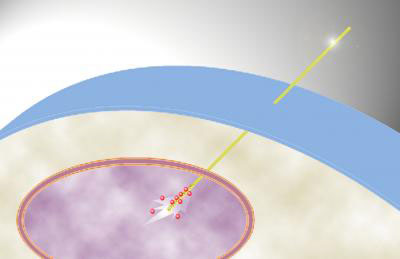 Getting an inside look at the center of a cell can be as easy as a needle prick, thanks to University of Illinois researchers who have developed a tiny needle to deliver a shot right to a cell's nucleus.
Getting an inside look at the center of a cell can be as easy as a needle prick, thanks to University of Illinois researchers who have developed a tiny needle to deliver a shot right to a cell's nucleus.
Sep 27th, 2010
Read more
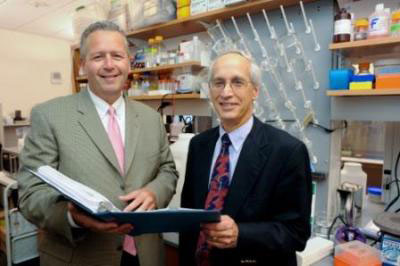 Grant will support the continued work of the center launched in 2005 as part of NC's Alliance for Nanotechnology in Cancer.
Grant will support the continued work of the center launched in 2005 as part of NC's Alliance for Nanotechnology in Cancer.
Sep 27th, 2010
Read more
The 5th General Assembly and Annual Forum of the European Technology Platform on Nanomedicine will take place at Centro Congressi Fondazione Cariplo in Milan, Italy on 14 and 15 October 2010.
Sep 27th, 2010
Read more
A team led by engineers and physicists at the University of New South Wales (UNSW) in Sydney, Australia, have developed one of the key building blocks needed to make a quantum computer using silicon: a 'single electron reader'.
Sep 27th, 2010
Read more
Rensselaer Polytechnic Institute researchers win $2 million NSF grant to develop capacitive energy storage system for renewable power source.
Sep 27th, 2010
Read more
Two UK companies have been awarded joint funding for a research project that could see significant advances in the quest to aid detection and eradication of Tuberculosis (TB), across the world.
Sep 27th, 2010
Read more
 University of Michigan scientists using AFOSR-funding have created the smallest pixels available that will enable LED, projected and wearable displays to be more energy efficient with more light manipulation possible and all on a display that may eventually be as small as a postage stamp.
University of Michigan scientists using AFOSR-funding have created the smallest pixels available that will enable LED, projected and wearable displays to be more energy efficient with more light manipulation possible and all on a display that may eventually be as small as a postage stamp.





 Subscribe to our Nanotechnology News feed
Subscribe to our Nanotechnology News feed